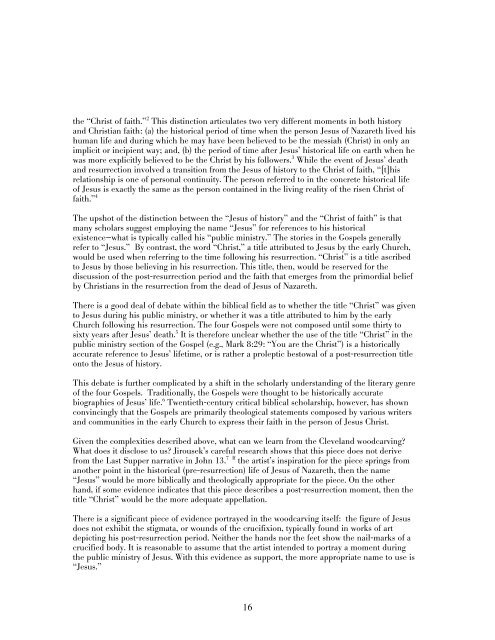SECTION 1 - via - School of Visual Arts
SECTION 1 - via - School of Visual Arts
SECTION 1 - via - School of Visual Arts
You also want an ePaper? Increase the reach of your titles
YUMPU automatically turns print PDFs into web optimized ePapers that Google loves.
the “Christ <strong>of</strong> faith.” 2 This distinction articulates two very different moments in both history<br />
and Christian faith: (a) the historical period <strong>of</strong> time when the person Jesus <strong>of</strong> Nazareth lived his<br />
human life and during which he may have been believed to be the messiah (Christ) in only an<br />
implicit or incipient way; and, (b) the period <strong>of</strong> time after Jesus’ historical life on earth when he<br />
was more explicitly believed to be the Christ by his followers. 3 While the event <strong>of</strong> Jesus’ death<br />
and resurrection involved a transition from the Jesus <strong>of</strong> history to the Christ <strong>of</strong> faith, “[t]his<br />
relationship is one <strong>of</strong> personal continuity. The person referred to in the concrete historical life<br />
<strong>of</strong> Jesus is exactly the same as the person contained in the living reality <strong>of</strong> the risen Christ <strong>of</strong><br />
faith.” 4<br />
The upshot <strong>of</strong> the distinction between the “Jesus <strong>of</strong> history” and the “Christ <strong>of</strong> faith” is that<br />
many scholars suggest employing the name “Jesus” for references to his historical<br />
existence—what is typically called his “public ministry.” The stories in the Gospels generally<br />
refer to “Jesus.” By contrast, the word “Christ,” a title attributed to Jesus by the early Church,<br />
would be used when referring to the time following his resurrection. “Christ” is a title ascribed<br />
to Jesus by those believing in his resurrection. This title, then, would be reserved for the<br />
discussion <strong>of</strong> the post-resurrection period and the faith that emerges from the primordial belief<br />
by Christians in the resurrection from the dead <strong>of</strong> Jesus <strong>of</strong> Nazareth.<br />
There is a good deal <strong>of</strong> debate within the biblical field as to whether the title “Christ” was given<br />
to Jesus during his public ministry, or whether it was a title attributed to him by the early<br />
Church following his resurrection. The four Gospels were not composed until some thirty to<br />
sixty years after Jesus’ death. 5 It is therefore unclear whether the use <strong>of</strong> the title “Christ” in the<br />
public ministry section <strong>of</strong> the Gospel (e.g., Mark 8:29: “You are the Christ”) is a historically<br />
accurate reference to Jesus’ lifetime, or is rather a proleptic bestowal <strong>of</strong> a post-resurrection title<br />
onto the Jesus <strong>of</strong> history.<br />
This debate is further complicated by a shift in the scholarly understanding <strong>of</strong> the literary genre<br />
<strong>of</strong> the four Gospels. Traditionally, the Gospels were thought to be historically accurate<br />
biographies <strong>of</strong> Jesus’ life. 6 Twentieth-century critical biblical scholarship, however, has shown<br />
convincingly that the Gospels are primarily theological statements composed by various writers<br />
and communities in the early Church to express their faith in the person <strong>of</strong> Jesus Christ.<br />
Given the complexities described above, what can we learn from the Cleveland woodcarving?<br />
What does it disclose to us? Jirousek’s careful research shows that this piece does not derive<br />
from the Last Supper narrative in John 13. 7 If the artist’s inspiration for the piece springs from<br />
another point in the historical (pre-resurrection) life <strong>of</strong> Jesus <strong>of</strong> Nazareth, then the name<br />
“Jesus” would be more biblically and theologically appropriate for the piece. On the other<br />
hand, if some evidence indicates that this piece describes a post-resurrection moment, then the<br />
title “Christ” would be the more adequate appellation.<br />
There is a significant piece <strong>of</strong> evidence portrayed in the woodcarving itself: the figure <strong>of</strong> Jesus<br />
does not exhibit the stigmata, or wounds <strong>of</strong> the crucifixion, typically found in works <strong>of</strong> art<br />
depicting his post-resurrection period. Neither the hands nor the feet show the nail-marks <strong>of</strong> a<br />
crucified body. It is reasonable to assume that the artist intended to portray a moment during<br />
the public ministry <strong>of</strong> Jesus. With this evidence as support, the more appropriate name to use is<br />
“Jesus.”<br />
16








